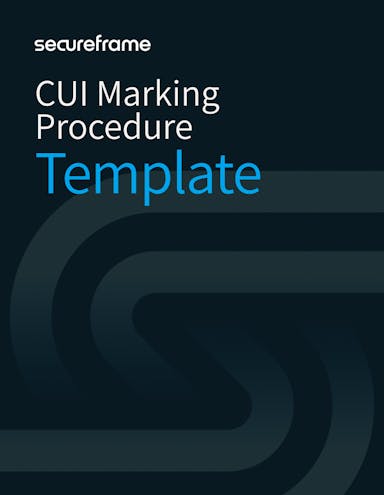
DoD Distribution Statements: What They Are and Why They Matter for Handling CUI
Emily Bonnie
Senior Content Marketing Manager
Rob Gutierrez
Senior Cybersecurity and Compliance Manager, CISA, CCSK, CMMC RP
If you’re working with the Department of Defense, whether as a prime contractor or part of the broader Defense Industrial Base (DIB), chances are you’ve come across a label like “Distribution Statement D” on a document. It might seem like bureaucratic boilerplate, but it’s actually an important marker that affects how you manage government information.
The challenge for many organizations is that these statements are easy to overlook, especially if staff are unfamiliar with what they mean or how they tie into regulatory compliance. That confusion can lead to inadvertent exposure of Controlled Unclassified Information (CUI), failed security assessments, and even disqualification from future DoD contracts.
Below, we’ll walk you through what each distribution statement means and how it connects to your compliance obligations under NIST 800-171 and CMMC 2.0.
What are DoD distribution statements?
A DoD distribution statement is a label applied to technical documents and materials developed by or for the Department of Defense (DoD). It specifies who is allowed to access and distribute the information, and are commonly found on documents like engineering drawings, technical manuals, test results, and research deliverables. They help control the dissemination of unclassified but sensitive information and are required under DoD Instruction 5230.24.
In addition to technical specifications, distribution statements may appear on proprietary information submitted as part of a contractor performance evaluation. For small businesses in particular, mishandling such information can result in lost contracts or disqualification from future opportunities — especially in the defense sector, where one mishandled document can jeopardize years of relationship building.
There are six distribution statements, ranging from A-F:
- Distribution Statement A: Approved for public release; distribution is unlimited.
- Distribution Statement B: Distribution authorized to U.S. Government agencies only.
- Distribution Statement C: Distribution authorized to U.S. Government agencies and their contractors.
- Distribution Statement D: Distribution authorized to DoD and U.S. DoD contractors only.
- Distribution Statement E: Distribution authorized to DoD components only.
- Distribution Statement F: Further distribution only as directed by the controlling DoD office.
How do distribution statements relate to CMMC 2.0 and NIST 800-171 compliance?
Distribution statements are backed by a combination of DoD directives, DFARS clauses, and broader federal regulations. For example, DoD Instruction 5230.24 outlines how distribution limitations are applied, while DFARS 252.204-7012 and various provisions in the Code of Federal Regulations (CFR) and U.S. Code (U.S.C.) establish the requirements for safeguarding technical data. These authorities often reference Executive Orders, DoD issuances, determinations by competent authorities, and other formal guidance from specific DoD authorities
While distribution statements themselves are not classified, they often appear on documents that contain or are derived from CUI. As a result, these labels are critical indicators that help your organization identify which information needs to be handled according to NIST 800-171 and CMMC 2.0 requirements.
Identifying CUI
Distribution Statements B through F are often applied to documents that fall under the CUI category. Documents that carry distribution statements often include export-controlled technical data, software documentation, or other forms of technical information that qualify as Controlled Technical Information (CTI). These materials may also fall under export regulations like ITAR (International Traffic in Arms Regulations), making proper handling even more critical.
If you receive a document with one of these statements, you should treat it as a potential CUI asset and apply proper safeguards. Accurately identifying CUI is a critical step in meeting compliance requirements, and failure to do so could lead to assessment findings or data breaches.
Access control requirements
Once identified, documents with restricted distribution must be protected under NIST 800-171 controls. These include limiting access to authorized personnel, tracking who accesses the document, and ensuring secure methods for storage and transmission.
For documents marked with Distribution Statement F, dissemination is tightly controlled. You must consult the controlling office listed on the document to determine whether the content is releasable and under what conditions. Often, a specific date of determination or guidance regarding further dissemination is included.
Documentation handling
CUI must be marked and handled according to its sensitivity and within the CMMC/NIST 800-171 requirements around Media Marking (MP.L2-3.8.4 Media Markings). Distribution statements provide an early warning that a document may require either secure storage, encryption at rest and in transit, role-based access controls, and/or controlled sharing protocols.
The reason these documents are so tightly controlled often comes down to national security. Whether it’s information intended for operational use, related to military support functions, or potentially exploitable vulnerabilities, improper handling can jeopardize operations security or lead to premature dissemination to foreign governments.
NIST 800-171 control mapping
NIST 800-171 lays out a roadmap for protecting CUI, and several controls directly apply when it comes to managing documents with distribution statements:
- 3.1.3: Control the flow of CUI in your systems.
- 3.1.5: Limit access to CUI based on roles and responsibilities.
- 3.8.4: Mark CUI appropriately.
- 3.8.5: Limit access to media containing CUI.
- 3.8.6: Sanitize media before disposal or reuse.
These controls are critical for both NIST 800-171 and CMMC 2.0 Level 2. During a CMMC assessment, your C3PAO will evaluate how effectively you identify and protect CUI. Documents with DoD distribution statements are an immediate area of focus.
If you don’t have clear processes for identifying and securing documents labeled with B through F statements, you could face compliance issues. On the other hand, demonstrating awareness of these labels and integrating them into your broader compliance strategy is a great way to show maturity and readiness.

CUI Marking Procedure Template
Want to make CUI marking easier? Download our free CUI Marking Template on CMMC.com to standardize your headers, footers, designation blocks, and email markings.
Best practices for handling distribution statements
Effectively managing documents with distribution statements starts with building awareness and enforcing consistent processes across your organization. These best practices can help you reduce risk, improve compliance, and strengthen your security posture.
Train your team to recognize and interpret distribution statements
One of the simplest and most effective steps you can take is to ensure your team knows what these labels mean. Engineers, program managers, document control staff, and IT teams all need to understand that a distribution statement isn't just a formality; it signals how information must be handled. Regular training and policy distribution and acknowledgements should cover what each statement type allows, how it relates to CUI, and what actions are required when a restricted label appears on a document.
Tag and track documents with B–F statements in your document management system
Once your team can recognize distribution statements, your next step is building those labels into your internal processes. Any document marked with Distribution Statements B through F should be tagged in your document repository as containing CUI or potentially sensitive information. Make sure these documents are easily searchable and that access logs show who has viewed, edited, or downloaded them. This kind of traceability is vital for both internal security and CMMC assessment preparation.
Restrict access to those documents based on need-to-know and clearance levels
It’s not enough to simply tag a document. You also need to make sure it’s only accessible to people who are authorized to view it. This means implementing role-based access controls and enforcing the principle of least privilege. For example, a software developer working on unrelated modules shouldn’t have access to technical schematics labeled Distribution D. Limiting access not only supports compliance but also significantly reduces your risk exposure if an account is compromised.
Apply technical controls that align with your CUI handling policies, including encryption and access logging
To round out your CUI protection strategy, reinforce your policies with technical safeguards. Use encryption for documents both at rest and in transit, especially when sharing across systems or with subcontractors. Set up automatic access logging and real-time alerts for any unauthorized access attempts. These tools not only help keep sensitive data secure, but they also provide a clear audit trail you can present during a CMMC assessment to demonstrate your organization is proactively managing risk.
Distribution statements might feel like fine print, but they play a big role in how you manage sensitive government data. If your team knows how to read the signs and respond appropriately, you are already ahead of the curve when it comes to CMMC 2.0 and NIST 800-171 compliance.

The CMMC Compliance Kit
This free kit is full of resources to help simplify your readiness work, including templates and checklists from our team of in-house federal compliance experts.
FAQs
Who assigns DoD distribution statements?
The originating DoD office or contractor assigns distribution statements when creating or delivering technical documents under DoD contracts.
What is a distribution statement?
A distribution statement is a label that specifies how a document can be shared and who can receive it, typically required for DoD-funded technical documents.
What is Distribution Statement B?
Distribution authorized to U.S. Government agencies only. This restricts the document from being shared with contractors or the public.
What is DoDI 5230.24?
DoD Instruction 5230.24 is the directive that governs the use of distribution statements on technical documents produced by or for the DoD.
Is Distribution Statement D considered CUI?
While the statement itself is not classified, documents labeled with Statement D typically contain CUI and should be protected accordingly.
What is a data controller vs a data processor?
GDPR differentiates between a data controller and a data processor, and not all organizations involved in data processing have the same responsibilities.
- Data controllers: The individual that decides how and why personal data will be processed. Example: Organization employees who manage or handle data.
- Data processors: Any third party that processes personal data on behalf of a data controller. Examples: Cloud service providers, email service providers.

Emily Bonnie
Senior Content Marketing Manager
Emily Bonnie is a seasoned digital marketing strategist with over ten years of experience creating content that attracts, engages, and converts for leading SaaS companies. At Secureframe, she helps demystify complex governance, risk, and compliance (GRC) topics, turning technical frameworks and regulations into accessible, actionable guidance. Her work aims to empower organizations of all sizes to strengthen their security posture, streamline compliance, and build lasting trust with customers.

Rob Gutierrez
Senior Cybersecurity and Compliance Manager, CISA, CCSK, CMMC RP
Rob Gutierrez is an information security leader with nearly a decade of experience in GRC, IT audit, cybersecurity, FedRAMP, cloud, and supply chain assessments. As a former auditor and security consultant, Rob performed and managed CMMC, FedRAMP, FISMA, and other security and regulatory audits. At Secureframe, he’s helped hundreds of customers achieve compliance with federal and commercial frameworks, including NIST 800-171, NIST 800-53, FedRAMP, CMMC, SOC 2, and ISO 27001.